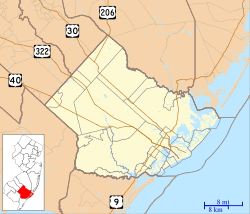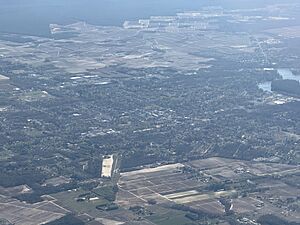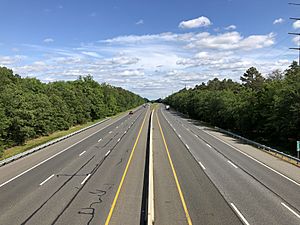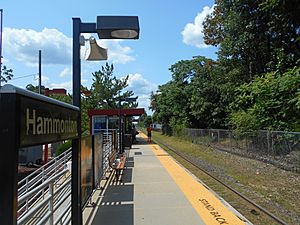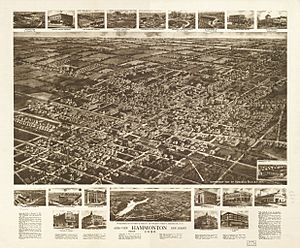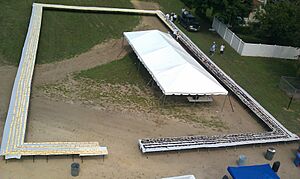Hammonton, New Jersey facts for kids
Quick facts for kids
Hammonton, New Jersey
|
||
|---|---|---|
|
Town
|
||
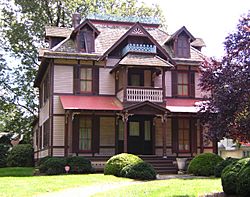
William L. Black House
|
||
|
||
| Nickname(s):
"Blueberry Capital of the World"
|
||
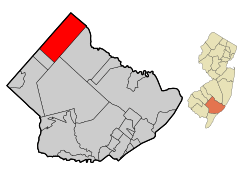
Location of Hammonton in Atlantic County highlighted in red (left). Inset map: Location of Atlantic County in New Jersey highlighted in orange (right).
|
||

Census Bureau map of Hammonton, New Jersey
|
||
| Country | ||
| State | ||
| County | Atlantic | |
| Incorporated | March 5, 1866 | |
| Named for | John Hammond Coffin | |
| Government | ||
| • Type | Town | |
| • Body | Town Council | |
| Area | ||
| • Total | 41.32 sq mi (107.01 km2) | |
| • Land | 40.75 sq mi (105.54 km2) | |
| • Water | 0.57 sq mi (1.46 km2) 1.37% | |
| Area rank | 50th of 565 in state 7th of 23 in county |
|
| Elevation | 62 ft (19 m) | |
| Population
(2020)
|
||
| • Total | 14,711 | |
| • Estimate
(2023)
|
14,797 | |
| • Rank | 179th of 565 in state 6th of 23 in county |
|
| • Density | 361.0/sq mi (139.4/km2) | |
| • Density rank | 464th of 565 in state 15th of 23 in county |
|
| Time zone | UTC−05:00 (Eastern (EST)) | |
| • Summer (DST) | UTC−04:00 (Eastern (EDT)) | |
| ZIP Code |
08037
|
|
| Area code(s) | 609 | |
| FIPS code | 3400129430 | |
| GNIS feature ID | 0885242 | |
| Website | ||
Hammonton is a town in Atlantic County, New Jersey. It is often called the "Blueberry Capital of the World" because of its many blueberry farms. In 2020, about 14,711 people lived there.
Hammonton is in the South Jersey area. It is part of a larger metropolitan area that includes Atlantic City. The town is located between Philadelphia and Atlantic City.
The first European settlers arrived in Hammonton in 1812. The town was named after John Hammond Coffin, whose father was an early settler. The name was first "Hammondton," but the "d" was dropped over time. Hammonton officially became a town on March 5, 1866. It was formed from parts of Hamilton Township and Mullica Township.
The NJ Transit's Atlantic City Line train passes through Hammonton. The Hammonton station is right in the downtown area.
Contents
Hammonton's History
Early Settlement and Growth
Before Europeans arrived, the Unalachtigo Lenape people lived in the Hammonton area. We know this from old stone tools found there. As more Europeans settled, the Lenape people moved away or became fewer due to sickness.
In 1812, William Coffin and his family moved to the area. They built a home and ran a sawmill near Hammonton Lake. Coffin bought the land and mill in 1814. The area was named "Hammondton" after Coffin's son, John Hammond Coffin. Later, the name became simply Hammonton.
In 1817, Coffin started a glass factory. This was possible because there was a lot of cheap wood and iron in South Jersey. These materials were important for making glass back then.
Farming and Railroads
Over time, Hammonton changed from making glass to farming. Farmers grew many strawberries and blueberries. A big change happened in 1854 when the Camden and Atlantic Railroad arrived. This railroad helped the town grow.
In 1856, two men, Charles K. Landis and Richard Byrnes, bought large areas of land near the new railroad. They sold smaller pieces of land to people who wanted to build homes and businesses. This moved the town closer to the railway. The Hammonton Railroad Station opened in 1858.
In 1866, Hammonton officially became a town. Its population was about 1,422 people. After this, many people from Italy moved to Hammonton. They helped the town grow and became a big part of its community.
Modern Times
The first Hammonton Blueberry Festival was held in 1953. This festival celebrates the town's important role in growing blueberries.
In 2022, a large wildfire happened in the Wharton State Forest near Hammonton. It burned over 15,000 acres of land.
Geography and Environment
Hammonton covers about 41.32 square miles (107.01 square kilometers). Most of this area is land, with a small amount of water.
The town is mostly flat because it is in the Atlantic Coastal Plain. The highest point in Atlantic County is actually in Hammonton. Hammonton is located almost exactly halfway between Philadelphia and Atlantic City.
The Pine Barrens
Hammonton is part of the New Jersey Pinelands National Reserve. This is a special protected natural area. It has unique plants and animals. The Pinelands is a United States Biosphere Reserve.
Because Hammonton is in the Pine Barrens, its soil is very sandy. This sandy soil is perfect for growing blueberries. Low, wet areas in the Pine Barrens are also used to grow cranberries.
Climate in Hammonton
Hammonton has a climate with cool winters and warm, humid summers. It gets a good amount of rain throughout the year.
| Climate data for Hammonton, New Jersey (1991–2020 normals, extremes 1930–present) | |||||||||||||
|---|---|---|---|---|---|---|---|---|---|---|---|---|---|
| Month | Jan | Feb | Mar | Apr | May | Jun | Jul | Aug | Sep | Oct | Nov | Dec | Year |
| Record high °F (°C) | 76 (24) |
77 (25) |
90 (32) |
95 (35) |
98 (37) |
103 (39) |
105 (41) |
104 (40) |
102 (39) |
95 (35) |
86 (30) |
77 (25) |
105 (41) |
| Mean daily maximum °F (°C) | 41.8 (5.4) |
44.7 (7.1) |
52.0 (11.1) |
63.7 (17.6) |
73.2 (22.9) |
82.3 (27.9) |
87.3 (30.7) |
85.1 (29.5) |
78.7 (25.9) |
67.4 (19.7) |
56.4 (13.6) |
47.0 (8.3) |
65.0 (18.3) |
| Daily mean °F (°C) | 32.8 (0.4) |
34.9 (1.6) |
41.5 (5.3) |
52.3 (11.3) |
62.1 (16.7) |
71.6 (22.0) |
76.9 (24.9) |
74.8 (23.8) |
68.0 (20.0) |
56.3 (13.5) |
45.9 (7.7) |
37.7 (3.2) |
54.6 (12.6) |
| Mean daily minimum °F (°C) | 23.9 (−4.5) |
25.0 (−3.9) |
31.1 (−0.5) |
41.0 (5.0) |
51.0 (10.6) |
61.0 (16.1) |
66.5 (19.2) |
64.4 (18.0) |
57.2 (14.0) |
45.3 (7.4) |
35.3 (1.8) |
28.5 (−1.9) |
44.2 (6.8) |
| Record low °F (°C) | −13 (−25) |
−8 (−22) |
4 (−16) |
15 (−9) |
29 (−2) |
34 (1) |
43 (6) |
42 (6) |
31 (−1) |
19 (−7) |
6 (−14) |
−5 (−21) |
−13 (−25) |
| Average precipitation inches (mm) | 3.49 (89) |
2.85 (72) |
4.31 (109) |
3.71 (94) |
3.54 (90) |
4.07 (103) |
4.45 (113) |
4.69 (119) |
4.06 (103) |
4.27 (108) |
3.51 (89) |
4.56 (116) |
47.51 (1,207) |
| Average snowfall inches (cm) | 5.7 (14) |
6.4 (16) |
2.9 (7.4) |
0.1 (0.25) |
0.0 (0.0) |
0.0 (0.0) |
0.0 (0.0) |
0.0 (0.0) |
0.0 (0.0) |
0.0 (0.0) |
0.2 (0.51) |
3.7 (9.4) |
19.0 (48) |
| Average precipitation days (≥ 0.01 in) | 11.1 | 10.1 | 10.9 | 11.9 | 12.3 | 12.3 | 11.9 | 10.6 | 9.5 | 11.6 | 9.2 | 10.8 | 132.2 |
| Average snowy days (≥ 0.1 in) | 2.9 | 2.8 | 1.5 | 0.2 | 0.0 | 0.0 | 0.0 | 0.0 | 0.0 | 0.0 | 0.1 | 1.4 | 8.9 |
| Source: NOAA | |||||||||||||
People of Hammonton
| Historical population | |||
|---|---|---|---|
| Census | Pop. | %± | |
| 1870 | 1,404 | — | |
| 1880 | 1,776 | 26.5% | |
| 1890 | 3,833 | 115.8% | |
| 1900 | 3,481 | −9.2% | |
| 1910 | 5,088 | 46.2% | |
| 1920 | 6,417 | 26.1% | |
| 1930 | 7,656 | 19.3% | |
| 1940 | 7,668 | 0.2% | |
| 1950 | 8,411 | 9.7% | |
| 1960 | 9,854 | 17.2% | |
| 1970 | 11,464 | 16.3% | |
| 1980 | 12,298 | 7.3% | |
| 1990 | 12,208 | −0.7% | |
| 2000 | 12,604 | 3.2% | |
| 2010 | 14,791 | 17.4% | |
| 2020 | 14,711 | −0.5% | |
| 2023 (est.) | 14,797 | 0.0% | |
| Population sources: 1870–2000 1870–1920 1870 1880–1890 1890–1910 1910–1930 1940–2000 2000 2010 2020 |
|||
Population Changes
In 2010, Hammonton had 14,791 people. This was a small decrease from 2010. The population density was about 361.8 people per square mile.
Many different groups of people live in Hammonton. In 2010, about 81.7% of the people were White. About 3% were Black or African American, and 1.4% were Asian. About 20.9% of the population was Hispanic or Latino.
In 2000, about 45.9% of Hammonton residents had Italian family backgrounds. This was one of the highest percentages in the United States for a town of its size.
Arts and Culture
The rock band The Early November is from Hammonton.
Sports in Hammonton
In 1997, there was a plan to create a minor-league baseball team called the Hammonton Blueberries. The idea was to build a baseball park. However, the plan did not happen, and the team was never formed.
How Hammonton is Governed
Local Government
Hammonton is run by a Mayor and a Town Council. The Mayor is elected for a four-year term. The Town Council has six members, and they are elected for two-year terms. Three council seats are up for election each year.
As of 2023, the Mayor of Hammonton is Steve DiDonato. He is an Independent. The Town Council members include Deputy Mayor Tom Gribbin, Steven Furgione, Jonathan Oliva, Renee Rodio, Sam Rodio, and Ed Wuillermin. Most of these leaders are part of a group called Hammonton First.
Voting and Elections
Hammonton is in New Jersey's 2nd Congressional District. It is also part of the 8th state legislative district.
In recent presidential elections, Hammonton voters have often supported Republican candidates. For example, in the 2020 election, Donald Trump received about 59.9% of the votes in Hammonton. In the 2016 election, he received about 60.1% of the votes.
| Year | Republican | Democratic | Third Parties |
|---|---|---|---|
| 2024 | 63.3% 4,697 | 35.1% 2,609 | 1.6% 96 |
| 2020 | 59.9% 4,560 | 38.9% 2,957 | 1.2% 94 |
| 2016 | 60.1% 3,859 | 36.8% 2,366 | 3.1% 198 |
| 2012 | 54.4% 3,420 | 44.1% 2,777 | 0.9% 57 |
| 2008 | 54.0% 3,509 | 44.5% 2,894 | 1.4% 89 |
| 2004 | 54.1% 3,218 | 43.7% 2,600 | 0.8% 47 |
Education in Hammonton
Students in Hammonton attend schools in the Hammonton Public Schools district. This district serves students from pre-kindergarten through twelfth grade. As of the 2023–24 school year, there were 3,326 students in four schools.
The schools in the district are:
- Early Childhood Education Center (PreK–1)
- Warren E. Sooy Elementary School (grades 2–5)
- Hammonton Middle School (grades 6–8)
- Hammonton High School (grades 9–12)
Students from Folsom Borough (grades 9–12) and Waterford Township (grades 7–12) also attend Hammonton schools. This is part of a special agreement between the school districts.
Hammonton was also home to Catholic schools, St. Joseph Regional Elementary School and St. Joseph High School. St. Joseph High School reopened in 2020 as the independent St. Joseph Academy.
Media and News
Hammonton has its own television station, WPSJ-CD Channel 8. Local newspapers include the Hammonton Gazette and Hammonton News. Larger newspapers like The Press of Atlantic City, Philadelphia Daily News, and The Philadelphia Inquirer also serve the area.
Transportation
Several major roads pass through Hammonton. These include the Atlantic City Expressway, U.S. Route 30, and U.S. Route 206.
Public Transport
The Hammonton station offers train service by NJ Transit. You can travel between Atlantic City and Philadelphia from this station.
NJ Transit also provides bus service in Hammonton on the 554 route. This bus goes between Lindenwold station and Atlantic City.
Airport
The Hammonton Municipal Airport is located about 3 miles (5 km) northeast of the town center.
Community Life
Blueberry Capital
Hammonton is famous for being the "Blueberry Capital of the World." The town has many blueberry farms. One farm is the largest blueberry grower in the Northeast.
Since the 1980s, the Red, White and Blueberry Festival has celebrated Hammonton's blueberry farming.
Presidential Visits
Several U.S. Presidents have visited Hammonton. Ronald Reagan came to Hammonton during his 1984 re-election campaign. He talked about Hammonton being the "Blueberry Capital."
Ulysses S. Grant and Theodore Roosevelt also made stops in the town.
Festivals and Events
Hammonton hosts many fun festivals each year. These include:
- The Red, White and Blueberry Festival
- Our Lady of Mount Carmel Festival (one of the oldest Italian festivals in the U.S., started in 1875)
- Hammonton Wine Festival
- Hammonton Fall Beer Festival
- Teen Arts Festival
- Hammonton Food Truck Festival
- Hammonton Green Day Festival
- Crusin Main Street
Downtown Area
Hammonton's downtown area has grown a lot in the last 20 years. It has art galleries, restaurants, shops, and a theater. There is also a park and a college campus. Many people from South Jersey come to shop and visit.
The downtown area hosts three parades every year: Halloween, Christmas, and Memorial Day. The annual Christmas Tree Lighting is a big celebration with carols, music, and Santa.
On the third Thursday of each month, the downtown has "Third Thursday Events" with different themes. Stores offer discounts, and performers entertain people on the street.
In 2013, Hammonton's downtown was a finalist for the Great American Main Street Award. This award recognizes towns that have successfully improved their downtown areas.
Special Achievements
In 1949, the Hammonton Little League World Series team won the championship. They were the first official team from outside Pennsylvania to win.
On July 24, 2011, Ricca's Italian Bakery set a Guinness World Record. They made the Longest Line of Cakes topped with fresh blueberries. Local farmers donated the blueberries.
In 2014, a study ranked Hammonton as the second-happiest city in New Jersey. This ranking looked at things like restaurants, how easy it is to get around, and housing.
Wineries and Breweries
Hammonton has three active wineries: DiMatteo Vineyards, Plagido's Winery, and Tomasello Winery.
The Eagle Theatre in Hammonton was the first theater in New Jersey to sell wine during shows. This started in 2013.
The town has also seen new craft breweries open since 2015. These include Tomfoolery Brewing Company, Three 3's Brewing Company, and Vinyl Brewing.
Hammonton in Popular Culture
Hammonton has appeared in movies and TV shows:
- The 2002 horror film 13th Child was filmed in Hammonton.
- An episode of the TV show Supernatural in 2011 was set in Hammonton.
- The HBO series Boardwalk Empire showed the town sign "Welcome to Hammonton, The Blueberry Capital of the World" in its first two episodes.
- In 2013, a girl from Hammonton, Sarah Restuccio, appeared on American Idol.
- The MTV reality show True Life featured an episode set in Hammonton in 2013.
- In 2013, parts of the independent film The Honour were filmed in Hammonton.
- A commercial for the clothing brand Chubbies Shorts was filmed in Hammonton in 2015.
Famous People from Hammonton
Many notable people have connections to Hammonton:
- Ashante "Thee" Adonis (born 1990), a professional wrestler.
- Tyler Bellamy (born 1988), a soccer player.
- Jill Biden (born 1951), an educator and the current First Lady of the United States.
- Reverend Gary Davis (1896–1972), a blues and gospel singer.
- J. D. DiRenzo (born 1988), an American football player.
- Ace Enders (born 1982), a musician.
- Marie Howland (1836–1921), a feminist writer.
- Johnnie O. Jackson (born 1971), a professional bodybuilder.
- Nelson Johnson (born 1948), an author whose book inspired the TV series Boardwalk Empire.
- Margaret Mead (1901–1978), a famous cultural anthropologist.
- Victor Moore (1876–1962), an actor.
- Rita Myers (born 1947), a video installation artist.
- George Washington Nicholson (1832–1912), a landscape painter.
- Thomas Ricca (born 1968), a former professional wrestler.
- Andrew Rider (1866–1898), the founder of Rider University.
- Tony Siscone (born 1949), a professional race car driver.
- Alma Joslyn Whiffen-Barksdale (1916–1981), a mycologist who discovered cycloheximide.
- Gary Wolfe (born 1967), a professional wrestler.
Sister City
Hammonton has a sister city relationship with San Gregorio da Sassola in Italy.
See also
 In Spanish: Hammonton (Nueva Jersey) para niños
In Spanish: Hammonton (Nueva Jersey) para niños



